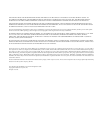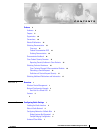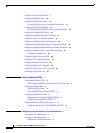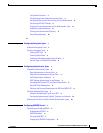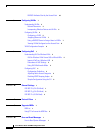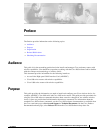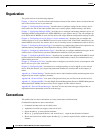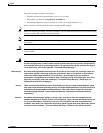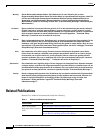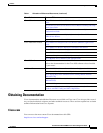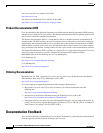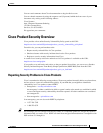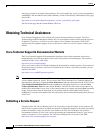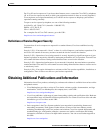
10
Cisco Wireless ISR and HWIC Access Point Configuration Guide
OL-6415-04
Preface
Organization
Organization
This guide consists of the following chapters:
Chapter 1, “Overview,” lists the software and hardware features of the wireless device and describes the
role of the wireless device in your network.
Chapter 2, “Configuring Radio Settings,” describes how to configure settings for the wireless device
radio such as the role in the radio network, data rates, transmit power, channel settings, and others.
Chapter 3, “Configuring Multiple SSIDs,” describes how to configure and manage multiple service set
identifiers (SSIDs) and multiple basic SSIDs (BSSIDs) on your wireless device. You can configure up
to 16 SSIDs and 16 BSSIDs on your wireless device and assign different configuration settings to each.
Chapter 4, “Configuring an Access Point as a Local Authenticator,” describes how to configure the
wireless device to act as a local RADIUS server for your wireless LAN. If the WAN connection to your
main RADIUS server fails, the wireless device acts as a backup server to authenticate wireless devices.
Chapter 5, “Configuring Encryption Types,” describes how to configure the cipher suites required to use
authenticated key management, Wired Equivalent Privacy (WEP), and WEP features.
Chapter 6, “Configuring Authentication Types,” describes how to configure authentication types on the
wireless device. Client devices use these authentication methods to join your network.
Chapter 7, “Configuring RADIUS Servers,” describes how to enable and configure the RADIUS, which
provides detailed accounting information and flexible administrative control over authentication and
authorization processes.
Chapter 8, “Configuring VLANs,” describes how to configure your wireless device to interoperate with
the VLANs set up on your wired LAN.
Chapter 9, “Configuring QoS,” describes how to configure quality of service (QoS) on your wireless
device. With this feature, you can provide preferential treatment to certain traffic at the expense of
others.
Appendix A, “Channel Settings,” lists the wireless device radio channels and the maximum power levels
supported by the world’s regulatory domains.
Appendix B, “Protocol Filters,” lists some of the protocols that you can filter on the wireless device.
Appendix C, “Supported MIBs,” lists the Simple Network Management Protocol (SNMP) Management
Information Bases (MIBs) that the wireless device supports for this software release.
Appendix D, “Error and Event Messages,” lists the CLI error and event messages and provides an
explanation and recommended action for each message.
Conventions
This publication uses these conventions to convey instructions and information:
Command descriptions use these conventions:
• Commands and keywords are in boldface text.
• Arguments for which you supply values are in italic.
• Square brackets ([ ]) mean optional elements.
• Braces ({ }) group required choices, and vertical bars ( | ) separate the alternative elements.
• Braces and vertical bars within square brackets ([{ | }]) mean a required choice within an optional
element.



